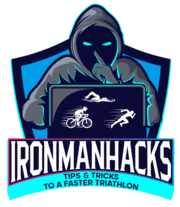An athlete of mine who is about to do his first marathon asked me if I had a checklist of things to prepare.
He also had a few questions about nutrition and more, so I’ve put together a quick guide on what you need to plan for and bring before a marathon.
One principle that can apply to all the items below is the age-old rule: Don’t try anything new on race day.
With that, let’s get into the list.

Here I am at about km 35 of the Singapore Standard Chartered Marathon, pretending to be feeling ok.
Shoes: Wear the same pair you’ve run your longest runs in. You need to be sure they will be comfortable after 42.2 km.
Don’t wear new, untested, or only partially-tested shoes for your race.
Socks: Same as shoes. Keep using what you’ve been using.
Shirt: Don’t wear the [untested] race shirt that you may have received in the race pack.
Personally, I like to wear something distinctive that stands out in photos and for my wife / family if they are going to be waiting for me at the finish to make it easier to find me. (See image of me in pink above!)
Shorts: I’d go with the lightest, simplest, least-likely-to-chafe pair I have. These days most have a pocket at the back which you could use for a gel or two.
Hydration: While it’s certainly not wrong to carry water – in fact you should do so on long runs alone – I would not do it during a full marathon that has aid stations.
I would ensure I’m hydrated the night before and right up to the race. I wouldn’t drink so much that I’d have to pee much but I’d rather pee than be dehydrated.
Then, I’d rely on the on-course aid stations for hydration and grab a cup at each, without stopping.
Nutrition: The night before, eat a good carb dinner. Nothing too heavy. Avoid many meats or oily foods as they’re harder to digest. All you want to do it ensure the glycogen stores in your muscles and liver are topped-up. You don’t need to pig out on pasta or eat large amounts.
Most courses will have nutrition (gels) during the run. However, some people may feel more comfortable with their own gels, as whatever the race offers may not sit well in your stomach.
Other people, like me, have no issues eating any type of gel, banana, gummy bear, or other random on-course nutrition, and can consider being less self-reliant.
The safest approach, however, is to carry a few gels on you. I’d think 3-4 would be enough for most people.
Race Belt: This one’s often overlooked. But as a triathlete, it’s not something I’ll forget.
Race belts are a way better option to hold your bib that safety pins. They are much easier and they don’t damage your clothes.
Also, some have loops that you can use to carry gels.
Hat: This is optional, and may be good if you are running in a hot or sunny location. In triathlons I like to take ice from aid stations and put it in my hat, but in most marathons I suspect this won’t be necessary, as most are pre-dawn.
A visor may be a good option too.
Sunglasses: Like a hat, they may not be needed. Totally up to you. But like everything else here, make sure you have tested them in advance.
For example, if you don’t want to wear them the entire time (like if your race starts in the dark), where and how are you going to carry them? In my case, I can put them on my head, on my visor, as in the image above, but that has been well-tested.
Watch: Most of us track our runs with a watch like a Garmin, Apple, Suunto, Wahoo, or other. Make sure your watch is charged the night before and that the screens you want for your marathon are set up.
I’d strongly advise against trying to configure new data screens the day before or the day of the race. It can be complicated if you don’t know what you are doing and then when you race you may not know how to use them properly or they may not be set up the way you want.
Have all those screens worked out weeks in advance.
Heart Rate Monitor: Like your watch, make sure this is charged the day before the race. If it’s the type that takes an external battery, like many of the chest straps, change the battery about two weeks before your race if it’s getting low or if you think it is.
This is a preventative measure. Better not touch it the day before the race.
Phone: We don’t see phones on courses in triathlons as they’re usually not allowed (not safe to cycle with one) but I see them in runs all the time.
You could bring a waist-pack or wear one of those phone armbands if you really want to carry your phone.
Some people may bring their phones along with headphones so they can listen to music, which I believe is allowed by most races. It may be good to check in advance, however.
Personally, I’ve never been a fan of carrying my phone. Here are some reasons I don’t ever run with a phone:
- I will not need the phone during a race, especially when I’m here to perform, not be social
- I do not want to be disturbed by any calls, messages, or other distractions the phone brings
- It’s extra complexity, weight, hassle, and is another way to get chafed 😬
- I like simplifying everything, so leaving the phone behind helps
- If you really want to listen to music, consider wearing a watch that can store music like many of the Garmins
Foot Pod (Like Stryd): These measure things like power, cadence, and other metrics and are useful analytics tools.
If you have one, just make sure it’s charged the night before, and put it on your shoe that night before.
Then don’t think about it.
Mindset: Mental preparation is the foundation to having a pleasant and fulfilling race. First of all, I hope you have realistic expectations about your race and finish time.
Based on that, you should have an idea of your split paces per km or mile, and you should have a pacing strategy.
The night before my marathon, I like to sit alone and think about my race.
I will envision myself starting, hitting regular split times, hydrating at aid stations, and I’ll mentally think through the course, if I’m familiar with it.
Also envision yourself crossing the finish line, stopping your watch, and looking at the clock.
Having a clear and realistic mental picture of how the day should play out can calm your nerves and reduce the amount of race-day thinking you may have to do.
Logistics: Answer all of these questions and you should be in good shape.
- How are you going to get to the race?
- Where does it start?
- When does it start?
- Which pen or start chute are you in?
- What time does that pen open?
- How early in advance do you want to arrive?
- Where will you park?
- Is there a bag drop?
- How and where will you meet your friends or family, especially if you don’t have your phone on you?
- Are the start and end locations the same?
- Will the start be really cold? If so, what will you wear and then how will you take that off if you get too hot while running?
Hopefully this gives you a good sense of what to prepare for before your marathon. In short, don’t do anything new on race day!

Leave a Reply
You must be logged in to post a comment.